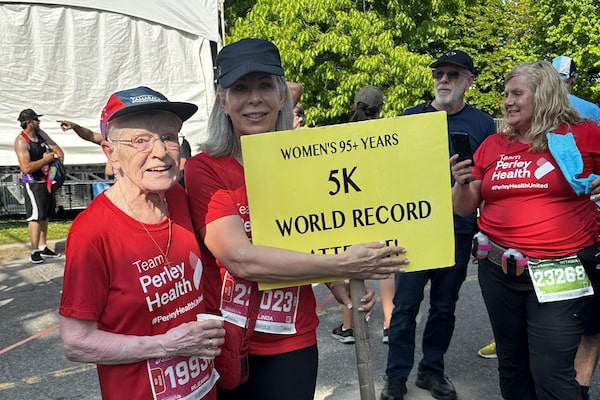
Ninety-six year old Rejeanne Fairhead, left, says until two years ago the most athletic things she had ever done involved bowling and horse shoes. Now she is a world-record holding racer.HO/The Canadian Press
In May, 2022, when Rejeanne Fairhead was 95 years old, she finished the five-kilometre Ottawa Race for ages 95 to 99 in 58 minutes and 52 seconds, a Canadian record. Participating in the challenge – let alone smashing a record – wasn’t a goal of hers; she didn’t do any training in advance. She was there simply to accompany a friend.
But, as it turned out, the 5K was a walk in the park for Fairhead, who treated it like any other stroll around her neighbourhood, stopping occasionally to chat with her pal. The next year, she thought: “Oh, I can beat that record,” she says. And, with a little determination, she shaved more than seven minutes off her time, finishing in 51 minutes and nine seconds – cinching the world record.
Fairhead credits her good health to a collection of little habits, not any kind of special exercise regime or diet. She walks in her neighbourhood, makes sure she stretches and keeps her brain sharp with puzzles and reading.
Here’s more on how the now 97-year-old stays fit.
Get your steps in
Even before she had her eyes set on the Ottawa Race, Fairhead went for a stroll nearly every day. She’s an active volunteer in her community, frequently walking to and from Perley Health, a long-term care home in her neighbourhood, to play cards or bingo with residents – who are sometimes decades younger. When the weather is nice, she’ll walk laps around the building.
Fairhead also gets her step count up by helping workers at the home with simple tasks. For example, during bingo, she’ll retrieve the cards from the players, going between them and the caller. “I’m up and down and back and forth – it’s a lot of walking,” she says.
Don’t look down on the power of simply walking: A 2022 study published in JAMA Internal Medicine found that for every 2,000 steps the risk of heart disease, cancer and premature death decreases by 10 per cent, peaking at 10,000 daily steps.
Small functional exercises go a long way
Though Fairhead didn’t meet with a trainer or hit the gym to prepare for her record-breaking walk last May, she did work with physiotherapist Richelle Weeks, who taught her some easy-to-do exercises. “They weren’t very difficult,” Fairhead says. “Just simple everyday exercises you can do all the time.” She never spent much time on the routine: just five minutes, every other day.
The moves were functional, focused on keeping Fairhead’s joints limber and maintaining her muscle strength. One was simply sitting down in a chair and standing up again, over and over. Basic, yes, but studies have shown that for older people, practising sit-to-stand repeatedly can be an effective way to improve muscle strength. It’s also a great way to improve mobility and balance, which can help decrease the risk of falls.
Stay busy
More than any other factor, Fairhead attributes her good health to always being on the go. Ruth McMahon, her daughter-in-law, says that the 97-year-old says “yes” to almost everything. “We recently had a family event at a pool hall and she was right in there with a cue, having fun.”
Fairhead also leads an active social life. She spends a lot of time chatting on the phone, with everyone from great-nieces and nephews to the adult children of her old friends. She often plays cards with a group of nearby women, or visits them for dinner.
Socializing and staying busy is integral to keeping seniors healthy, research shows. Aside from maintaining fitness levels, certain activities may improve older adults’ cognitive function. A study out of Penn State found that social interactions immediately affect cognitive performance that same day and for days later – which is important for staving off diseases such as Alzheimer’s.
Ultimately, Fairhead doesn’t see anything she does as extraordinary: She lives an active lifestyle that enables her to stay healthy with very little added effort. “People have stopped me and said I inspired them to get out there and do something, no matter their age, I’m very proud of that,” she says. “Age is just a number.”